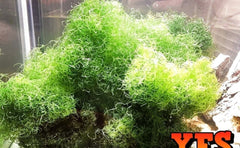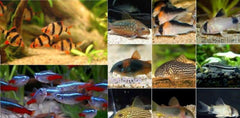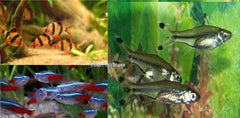100+ Fish Package - (X50) Tiger Barbs (X40) Assorted Cory Catfish (X10) Plecos
Ebay
$ 197.54

*100 FISH PACKAGE* x50 TIGER BARBS - x40 ASSORTED CORYDORAS CATFISH - x10 PLECOS
THIS PACKAGE INCLUDES:
x50 TIGER BARBS SM/MD 1/2"-1"
x40 ASSORTED CORYDORAS CATFISH 1/2"-1"
x10 PLECOS 1/2"-1"
****************
TIGER BARB FISH PACKAGE - LIVE FRESHWATER - FREE SHIPPING
The Barb is are a very lively, playful fish that prefers to be in schools.
They prefer a well-planted tank of at least 30 gallons with soft, slightly acidic water. Rocks and driftwood can be added to the aquarium, but leave plenty of space for swimming. The Barb is a very active fish that may pester or even nip the fins of larger, slower moving fish.
It is best, when trying to breed the Barb, to house a number of Barbs in the same aquarium until they pair off. After a pair has developed, the female will lay the eggs and the male will follow behind to fertilize. The fry will be free-swimming after about 5 days. Feed the fry newly hatched brine shrimp until large enough to accept crushed flake food.
The Barb needs to be fed a variety of foods including vegetables as well as meaty foods. Feed a quality flake food as well as live and frozen foods such as brine shrimp and bloodworms.
They are a very lively, playful fish that prefers to be in schools.
They prefer a well-planted tank of at least 30 gallons with soft, slightly acidic water. Rocks and driftwood can be added to the aquarium, but leave plenty of space for swimming. The Barb is a very active fish that may pester or even nip the fins of larger, slower moving fish.
It is best, when trying to breed the Barb, to house a number of Barbs in the same aquarium until they pair off. After a pair has developed, the female will lay the eggs and the male will follow behind to fertilize. The fry will be free-swimming after about 5 days. Feed the fry newly hatched brine shrimp until large enough to accept crushed flake food.
The Barb needs to be fed a variety of foods including vegetables as well as meaty foods. Feed a quality flake food as well as live and frozen foods such as brine shrimp and bloodworms.
****************
Assorted Corydoras Catfish- Live Freshwater Tropical Catfish - Free Shipping
They will be scooped out our holding tanks. We cannot guarantee we will be able to scoop ALL different types, but we will try to get a good variety.
The assortment will be randomly selected from the list below:
Agassizi Corydoras
Albino Aeneus Corydoras
Emerald Green Corydoras
Fowleri Corydoras
Fowleri Corydoras
Green Aeneus Corydoras
Assorted Corydoras
Assorted Corydoras
Julii Corydoras
Leucomelas Corydoras
Melini Corydoras
Melini Corydoras
Metae Corydoras
Paleatus Corydoras
Paleatus Corydoras
Panda Corydoras
Pygmy Corydoras
Schwartzi Corydoras
Skunk Corydoras
Sterbai Corydoras
Adolfoi Corydoras
Emerald Green Corydoras
Gold Panda Corydoras
Robust Corydoras
Narcissus Corydoras
Pretty Corydoras
Armatus Corydoras
Napoensis Corydoras
Schultzei Corydoras
Green Stripe Aeneus Corydoras One of the best things is that
Cory Catfish care is easy. Corys have a calm, peaceful and non-aggressive temperament. Some Cory Catfish types are more shy and timid than others. This may also have something to do with their size relative to the other fish in the tank. It also can be related to the tank dynamic in general. Corydoras Catfish are active and curious bottom dwellers, methodically scavenging the tank bottom looking some food to eat.
Cory Catfish can be very active during the day, but they can also spend time peacefully resting motionless in the same spot. Corys may move about the tank at night, but they seem to be more active during the daytime hours.
Tank Size: Cory Catfish can do well in covered tanks of nearly any size and dimensions. Many beginner hobbyists keep Corydoras Catfish in small tanks like 10 gallon aquariums. Cory Cats can thrive in larger tanks too. Either way, hobbyists need to remember that all living species tax the bio-load capacity of a tank. So it’s important to be mindful of fish count and overstocking. It’s also important to keep tanks thoroughly covered because Corys often dart up to the surface to grab a bite to eat or get a gulp of air. Hobbyists will often hear a snapping or popping sound as the Cory Cat breaks the water surface and moves quickly to the bottom of the tank. This is normal behavior and should not be considered a sign the water lacks oxygen, provided aquarium care is adequate.
Cory Catfish School Together: Cory Catfish are very social creatures, especially with others of their kind. While Cory Cats can survive alone, they seem much happier in a group of two or more. Two Cory Cats of the same type will often stay close to one another as they move throughout the tank to feed. This is especially true when they rest. When one Cory Cat takes a break in the corner of a tank, other Cory Cats will almost always be seen an inch or two away. Two Cory Cats of different types may behave the same way. But in general, Corys of the same type seem to stick together most often.
If aquarium size permits, Cory Catfish school in groups of six or more. Cory Catfish schooling behavior is a pretty interesting thing to see as the fish move throughout the tank synced like a precision dance ensemble.
Cory Catfish Size: Depending on the specific type, Cory Catfish size can range from about 1 inch to about 2.5 inches in length. Their diameter can range from about the size of a dime to about the size of a nickel. They are thicker near their heads and taper off near the tail, creating triangle shaped look.
Cory Catfish On Black Substrate
Habitat: A Cory Catfish is a bottom dweller, so it’s a good idea to keep at least 2 inches of aquarium gravel or substrate on the tank bottom. Cory Catfish also seem to really enjoy a tank with lots of live plants. Live aquarium plants provide cover and hiding places for the fish to rest. Finally, be sure to include rocks and decorations that provide places to explore.
Water Parameters: While Corydoras Catfish can do well in a wide range of water conditions, keeping the fish in established community tank water is a safe bet:
Aquarium pH: 7.0 – 7.8,
Temperature: 72 – 78 Degrees Fahrenheit
Lighting: Standard community tank lighting will suffice
While aquarium pH and water temperature can extend beyond the traditional community tank range, itsimportant to maintain stability. So avoid sudden shifts in conditions. Make sure Ammonia and Nitrite levels are kept at 0 ppm, and control Nitrate buildup with regular partial water changes.
Poor Water Conditions: Cory Cats do not do well in tanks with poor water conditions. High Nitrates seem to stress Cory Cats and make them susceptible to diseases. Also avoid excessively stirring up the tank bottom while cleaning. This can release a large amount of decaying organic matter into the water column and start a bacterial bloom. The same goes for rearranging decorations. Corydoras Catfish may develop white patches around their mouths and barbels. This condition needs to be treated right away. If left untreated, Corydoras Catfish will stop eating, grow visibly thinner over time and eventually die.
Cory Catfish Diet And Feeding
Cory Catfish diet includes basic food types including fish flakes, pellets and bottom feeder tablets. Cory Cats will spend hours on end making their way across the tank bottom poking around for food. They will even move the surface gravel around a bit with their mouths, digging for more. While their feeding ability makes Corydoras Catfish really good tank cleaners, they should not be considered a substitute for proper tank care.
While Corydoras Catfish are adept at scavenging for otherwise uneaten food, the Cory Catfish diet cannot be mere left-overs. Left-overs may be in short supply so hobbyists need to make sure Cory Cats are getting their nutritional requirements met with supplements intended specifically for them. That said, avoid the temptation to overfeed. Only feed Cory Cats an amount of food that can be eaten in about 5 minutes.
Cory Catfish Lifespan
Durable and hardy, Cory Catfish lifespan can be long compared to other fish. Cory Catfish lifespan can be 5 years, or significantly more, under the right conditions. That said, it’s not uncommon for some Cory Cats to die shortly after being added to a tank. This could be due to the stress of being transported or shifts in water parameters between home tank water and store display water. Corydoras Catfish are not as prone to this as the more delicate Otocinclus Catfish are, but it’s still a possibility worth mentioning.
Cory Catfish Tank Mates: Peaceful & Calm
Cory Catfish tank mates include most community tank fish as long as they are non-aggressive and friendly in nature. Otocinclus Catfish, Tetras, Swordtails and of course other Corys can be a good fit. Cory Catfish tank mates can also include filter feeding shrimp such as Bamboo Shrimp and fan feeding shrimp like Vampire Shrimp. Cory Catfish tank mates can be Amano Shrimp, Red Cherry Shrimp and Ghost Shrimp. Freshwater Snails can include Gold Inca Snails, Ivory Snails, Mystery Snails, Ramshorn Snails, Pond Snails, Malaysian Trumpet Snails and Nerite Snails. Cory Cats should not be kept with cichlids or aquarium crayfish. Roughens like Oscars, Texas Cichlids and Jack Dempsey can injure Cory Catfish, or may even eat them outright.
Some hobbyists really enjoy keeping this small peaceful fish. Even though they are small bottom feeders, they can come across as very active, alert and entertaining to watch. And Corys can really be interesting as they feed and interact with different types of snails and shrimp. Its not uncommon for Corys to feed right next to their tank mates. They seem able to get along without scaring some of their smaller tank mates away. A group of different tank mates can hover over a bottom feeder pellet for a long time without incident. And Corys can even feed in close quarters with Otocinclus Catfish without spooking the Otto, which is pretty rare. Ottos are a delicate fish that almost always play it safe.
****************
PLECO CARE
The name "plecostomus" means "folded mouth" Pleco is a common name for fish from the familyLoricariidae but has extended to the family Hypostomus plecostomus known as a sucker fish
Many types of suckermouth armoured catfishes remain undescribed. As a result, they are given a common name and an L-number designation until a new scientific name is agreed upon.
They are extremely popular in aquariums for their ability to clean tanks by eating algae growth and dead fish.
Plecos are omnivorous, but in the wild feed nocturnally mostly on plant material. During the day, their unusual omega irises block a lot of light out of their eyes, but they are usually open at night. They can roll their eyes within their sockets, giving the appearance of winking. Plecos are usually skittish and quickly hide whenever they sense danger.
Appearance:
All three suckermouth catfishes (family Loricariidae) in Florida have rows of bony plates covering all but their belly area. Sailfin catfish are distinguished by worm-like pattern of dark markings on the head over a dark-golden background; pectoral fins stout with rough surfaces resembling course sandpaper; disc-like, protrusible mouth is under the head, and used like a suction cup to attach and feed on algae; females tend to be smaller, and fish larger than 18 inches probably males; lifeless and hollowed-out 'armored' bodies sometimes seen on canal and lake banks
Customer Reviews
No reviews yet
Write a review
QUESTIONS & ANSWERS
Ask a Question-
do you have a 50 fish deal ???
Thank you for contacting YourFishStore. At the moment this is the smallest package which is cost-effective to ship out. Overnight priority Shipping cost would outweigh the cost of the package if we made it any smaller.














